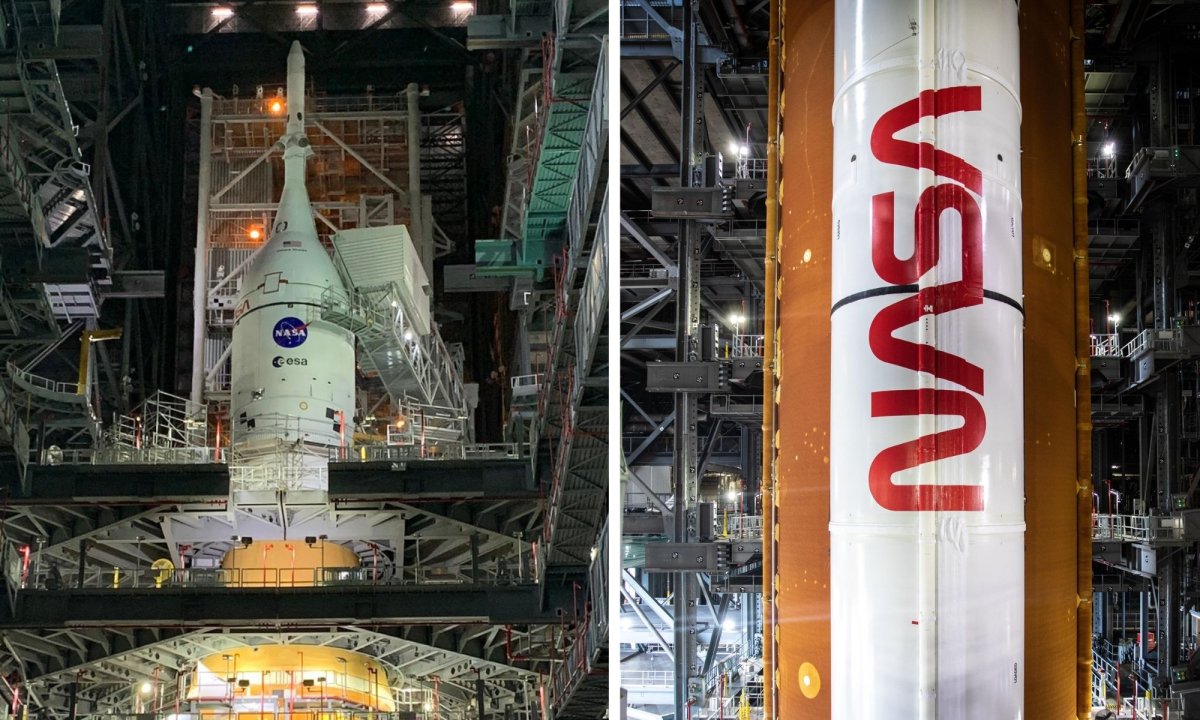NASA's Space Launch System (SLS), the world's most powerful rocket, is due to be rolled out onto a launch pad in Florida on Thursday ahead of the first moon mission in decades.
The rocket and the Orion spacecraft that is attached to it will play a vital part in the Artemis I space mission, which will not just see the return of a crewed mission to the moon since 1972, but will also result in the first woman and person of color stepping foot on the lunar surface. NASA has said the crewed mission will happen no earlier than May 2022.
Current preparations come ahead of the planned launch of the uncrewed rocket and Orion spacecraft on April 3, 2022, NASA officials said in a press conference. The uncrewed Orion spacecraft will journey to an orbit 40,000 miles beyond the Moon, or 280,000 miles from Earth.
At a height of 322 feet (ft), making it taller than the 305ft Statue of Liberty, the SLS will be the largest rocket to move to a launchpad since the Saturn V launched on its last mission in 1973, when it carried the Skylab space station into orbit around Earth. Its size has seen NASA dub it a Mega-Moon rocket.
NASA says that the four-mile journey from the Vehicle Assembly Building to the launch pad at NASA's Kennedy Space Center in Florida, where the SLS was recently adorned with the NASA logo, will take between 6 and 12 hours. It will be carried on the back of NASA's 6.6-million-pound crawler vehicle.
Space exploration fans will be able to watch the rollout as it happens from 5 p.m. EDT on Thursday, March 17, on NASA TV or on the agency's website.
Painting of the NASA worm logo is complete on the SLS solid rocket boosters for the #Artemis I mission ahead of rolling to the pad on March 17 for the final test. Painters had to wait until the boosters were fully assembled to finish the job.
— NASA_SLS (@NASA_SLS) March 15, 2022
MORE HERE >> https://t.co/H58Ol2R8Vx pic.twitter.com/lasgTl3RR8
When the SLS finally blasts off its two solid rocket boosters and four RS-25 liquid propellant engines will provide 8.8 million pounds of thrust. This is 13 percent more thrust than the Space Shuttle was launched with, and 15 percent more than the Saturn V blast-offs that also carried crew to the moon.
The solid rocket boosters provide around 75 percent of the thrust within the first two minutes of flight. The incredible power of the launch system will allow the Orion spacecraft to reach a speed of 24,500 miles per hour, the velocity needed to reach the lunar surface.
The rocket won't have to carry the weight of these two boosters all the way to the moon, however. They will separate off allowing the SLS to carry greater payloads further through space, with NASA saying its first configuration, named Block 1, will be able to send 59,500 pounds or 27 metric tonnes—about the same weight as almost five fully grown elephants—to the Moon.

The first three Artemis missions will use this Block 1 configuration, but this won't be the limit of the rocket, however. The SLS is designed so it can evolve into increasingly more powerful configurations, all built around the core stage with four RS-25 engines.
Block 1B will use this core in conjunction with a new, more powerful Exploration Upper Stage (EUS), which will allow for even more ambitious missions. NASA says that this will include the launch of the Orion crew vehicle alongside large cargos, of up to 38 tonnes, for the exploration systems needed to form the foundation of humanity's sustained presence on the Moon.
After this, the planned Black 2 configuration should provide 9.5 million pounds of thrust and will allow the SLS to carry even larger exploration systems up to 46 tonnes, not just to the moon, but to humanity's next planned stop in the solar system, Mars.

When the SLS reaches the launch pad the system will undergo what NASA calls a "wet dress rehearsal." This will include the loading of the propellant tanks that will carry the rocket to space and a launch countdown.
NASA's Artemis website states that the wet dress rehearsal will be the final major test for the Artemis I mission ensuring the rocket, spacecraft, ground equipment, and launch team are "go" for launch.

Uncommon Knowledge
Newsweek is committed to challenging conventional wisdom and finding connections in the search for common ground.
Newsweek is committed to challenging conventional wisdom and finding connections in the search for common ground.





